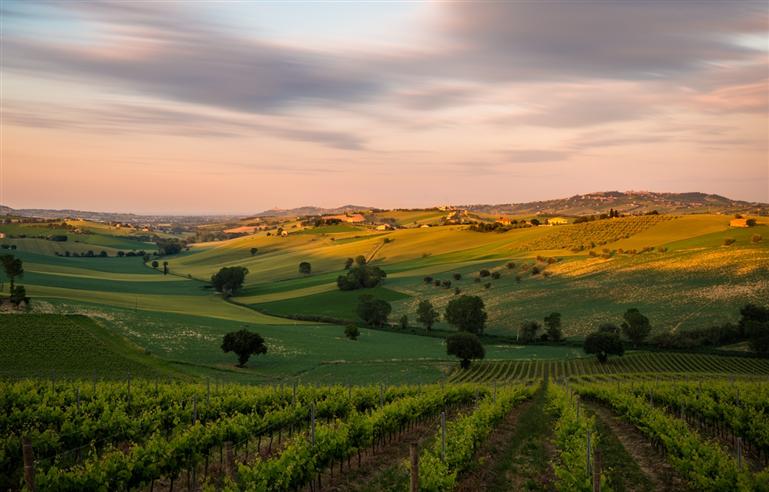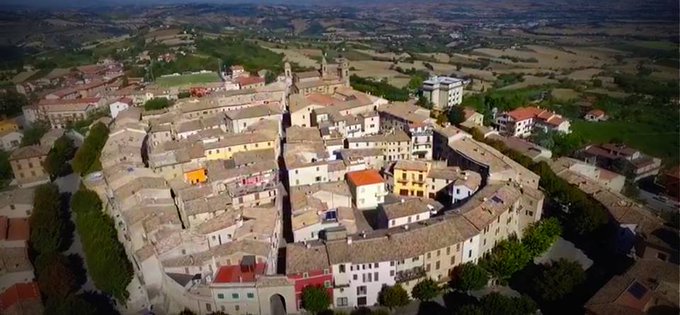
Sitting at 440 metres above sea level, Staffolo, like many of the hill-top towns in the Marche region, enjoys an enchanting and extensive panorama, with the village belvedere offering uninterrupted views over three river valleys: the Vallesina, the Valmisa and the Valmusone. On clear days one can take in views over the Adriatic Sea, stretching as far as the islands off the Croatian coast.
The name Staffolo appears to have several origins: in Greek language, σταφύλια (staffilia), means grape, and may refer to the primary occupation of the area’s residents; another legend harks back to the mythical figure of Staffilo, son of Ariadne and Theseus, who established the area; another, given its position between the Byzantine domains of Vallesina and the Duchy of Spoleto, hints at the Lombard term staffil, meaning boundary.

The centre of the village is made up of an elliptical medieval structure, and is surrounded by walls into which two entrance gates, one to the north and one to the south, give access to the town; inside the walls the Torrione dell’Albornoz stands out, dating back to 1300, as well as a series of other towers, some of which are still inhabited today.
The cultivation of Verdicchio grapes has always been of huge importance to the whole region and for the area’s economy in particular, and still today the town’s self-pride and wealth are inextricably linked to its wine production, enduringly famous all over the world: a 14th century work by Matteo Villani speaks of “Castello di Staffole, overflowing with wine”.
It’s a remarkable wine which was classified as DOC in 1968 and Controlled and Guaranteed Designation of Origin in 2010: DOCG Verdicchio Classico dei Castelli di Jesi, and DOCG Verdicchio di Jesi, produced with a minimum percentage of 85% of the autochthonous grape variety of the same name; the remaining 15% can be made up by grapes such as Malvasia Toscana or Trebbiano Toscana, even if the prevailing trend is to vinify with Verdicchio grapes alone.
The production of Verdicchio certified as DOCG Classico takes place in the towns and villages located in the valleys close to the Esino River, demarcated by a line that descends south from Ostra-Arcevia to Cupramontana-Apiro. Outside this area, including around Cingoli and Senigallia, Verdicchio dei Castelli di Jesi DOCG is produced.
This grape lends itself to various types of vinification: thanks to its structure, its soil and microclimatic conditions, it can be produced in versions such as sparkling, dry, reserve and passito, and an excellent grappa is obtained from its pomace.
Verdicchio has a typical light colour with a greenish tinge, is fragrant and pleasantly fresh, characterized by aromas of wild flowers and hawthorn, with subtle fruity hints of peach, apple and citrus, with a very particular aftertaste of bitter almond.
The combination is perfect with appetisers, fish and grilled dishes. That said, it’s also a perfect match for white meats such as rabbit in potacchio or traditional Marche-style porchetta.
The town’s restaurants and taverns offer wine tasting accompanied by local culinary specialities, and the village baker makes cavallucci, a classic local dessert made of sweet dough with a filling of almonds and sapa, a cooked grape must.
Visiting Staffolo allows us an insight into agricultural culture, gastronomy and its traditions. In this regard the Museum of Wine and Peasant Civilisation and the Enoteca wine shop really do merit a visit. On winery open days, or by prior appointment, you can visit the area’s wine producers, of which the more established ones organise guided tours and tastings, but you’ll find excellent products in the smaller ones just the same.
The Città di Staffolo Awards take place in July, set up by the town to celebrate contemporary artists, while in the third week of August the Verdicchio Festival is held, featuring conferences, dancing, music and exhibitions on the subject of agriculture, an opportunity to get to know the area and its produce in a welcoming, convivial atmosphere.


